Among the many attributes of Honeycrisp that make it grower unfriendly: the cultivar is exceptionally susceptible to fruit rot organisms that may require control measures that go beyond regular fungicide applications.
Honeycrisp is not only more susceptible to summer rots that occur in the orchard, but is very susceptible to postharvest decays from blue mold and gray mold.
That was the message from Dr. David Rosenberger, plant pathologist and professor emeritus at Cornell University’s Hudson Valley Laboratory. He spoke to growers during a Honeycrisp intensive workshop put on by the International Fruit Tree Association in Halifax, Nova Scotia, in February.
The message was especially cogent for Nova Scotia growers, whose orchards are recovering this year from a severe outbreak of fire blight caused by Hurricane Arthur last July 5.
Fruit rot pathogens can colonize dead and dying wood, Rosenberger said, and then sporulate profusely.
“They may be especially prevalent following fire blight outbreaks because shoots killed by fire blight are often rapidly invaded by one or more of these pathogens,” he said. “They also colonize prunings left beneath trees throughout the summer.”
Three rots
The three most common summer fruit rots are black rot (Botryosphaeria obtusa), white rot (B. dothidea) and bitter rot (Colletotrichum species).
The Botryosphaeria pathogens also colonize fruitlets that are dead but persist on trees after poor pollination or thinning sprays. “The first infected fruit during summer often are located beneath a dead fruitlet that provided the inoculum for the fruit infection,” Rosenberger said.
Most mature orchards have an abundance of inoculum for all three of these pathogens and fruit must
be protected with fungicides throughout summer, he said.
In orchards where bitter rot has caused severe losses, rotted fruit should be removed from beneath trees after harvest to reduce the level of overwintering inoculum.
“Fungicides alone are sometimes unable to control bitter rot if inoculum levels are high and hot summer weather favors fruit infections,” he said.
White rot and black rot are fairly easy to control with commonly used fungicides if coverage is maintained throughout summer, he said. Late-season rains can deplete fungicide residues, leaving fruit vulnerable.
Growers should continue sprays even as harvest approaches because that gap in coverage can lead to decay in storage during the cool-down period.
“Postharvest fungicide treatments usually will not arrest infections that were initiated in the field,” he said. Fruit in the center of the stack in large storages is most vulnerable because they are slowest to cool down.
Bitter rot
Honeycrisp are very susceptible to bitter rot, Rosenberger said, and for reasons unknown, fungicide treatments sometimes do not control it very well.
Rosenberger said he suspects that bitter rot outbreaks sometimes occur when sun-exposed fruit sustains heat injury without developing typical sunburn.
Initial decay on injured fruit may generate an abundance of inoculum that then initiates additional infections.
In most Northeastern and Great Lakes regions, sun injury is not a big problem, and bitter rot used to be considered “a southern disease,” he said. But it has reached Honeycrisp in the Hudson Valley and even further north.
Heat injury in the Northeast and Great Lakes areas has not been well-researched, he said. It may be that heat stress inactivates host defenses. Trees under water stress will close stomata and shut down their evaporative cooling system, allowing more rapid heating of fruit.
Rosenberger recommends that orchardists facing bitter rot problems:
—Remove dead wood during winter.
—Remove rotted fruit on the ground after harvest.
—Consider irrigating to soil-saturation ahead of heat waves.
—Consider applying fresh fungicide ahead of heat waves.
—Consider avoiding calcium sprays just prior to predictions of temperatures above 90˚F.
—Consider overhead sprinkler irrigation, reflective coatings, or hail nets to reduce sunlight intensity.
The best fungicide for bitter rot control is captan, applied at full rate at 10- to 14-day intervals, especially ahead of warm, wet weather, Rosenberger said.
Pristine (boscalid, pyraclostrobin), Merivon (Xemium, also known as fluxapyroxad, with pyraclostrobin), and Flint (trifloxystrobin) are moderately effective, but should be used along with captan under high disease pressure.
Two molds
Honeycrisp is prone to postharvest rots that infect wounded tissue. Gray mold (Botrytis cinerea) is easier to control than blue mold (Penicillium expansum) and should be controlled with postharvest drenching or fogging.
Blue mold, on the other hand, can be made worse by drenching. If fruit must be drenched, Rosenberger said, include Penbotec (pyrimethanil) or Scholar (fludioxonil) in the drench solution.
Blue mold spores, which come from decayed fruit, contaminate soil, bins, and storages and survive year to year. Spores in drench solutions infect apple wounds, and spores in storage rooms get blown about during storage filling.
Rosenberger recommends these steps for control:
—Minimize puncture wounds, perhaps by clipping stems.
—Sanitize storage bins and storage rooms that will be used for holding Honeycrisp. Quaternary ammonia, the standard treatment, is very effective if surfaces are warm. Sodium hypochlorite is ineffective unless exposure time is longer than 15 minutes, especially if bins or treated surfaces are cool at the time of treatment.
—Manage storage and packing to avoid contamination by spores. •

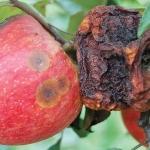
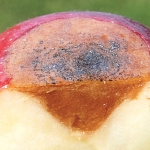
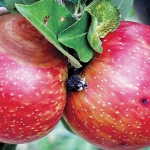
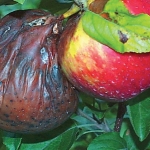



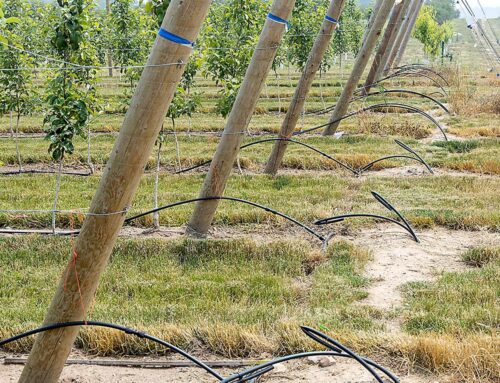

Leave A Comment